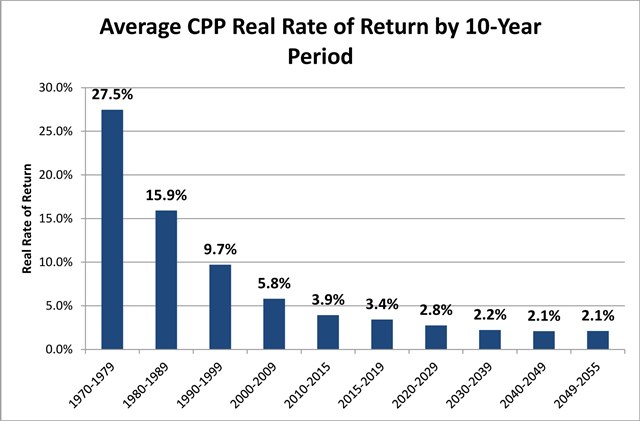CPP Returns and generational inequity
The Institute recently released a study that calculated rates of return (nominal and real) received by Canadian retirees from the Canada Pension Plan (CPP). One of the main reasons for the study was to clarify the difference between returns earned by the investment arm of the CPP (Canada Pension Plan Investment Board) and the actual returns received by retirees in the form of CPP retirement benefits.
One of the near-constant questions received during media related to generational equity. While not a focus of the study, the results clearly show a marked generational gap in the benefits received from the CPP depending on when a person was born.

The figure above shows the average rate of return (adjusted for inflation) for 10-year periods starting in 1970. The time periods represent when people retired. Thus, the 1970-1979 time period includes Canadians born between 1905 and 1914. The analysis assumes people retired when they reached 65 years of age.
As clearly demonstrated in the figure, Canadians retiring in 1970-1979, which is one of the earliest cohorts to receive CPP benefits, enjoyed an average rate of return of 27.5 per cent. The rates of return within this time period ranged from 39.1 per cent for those born in 1905 to 21.6 per cent for those born in 1914. Any investor would leap at these returns.
There is a pronounced decline in the returns in the very next time period. The average rate of return for those retiring in 1980-1989 was 15.9 per cent, almost half the rate of the previous period.
The rates of return continue to fall as the time period is extended: 2020-2029 (2.8 per cent), 2030-2039 (2.2 per cent), and 2040 and thereafter (2.1 per cent).
There are two principal reasons for the marked declines in the rates of return. First, retirees in the early periods paid into the CPP over a shorter time period compared to younger Canadians. Second, the contribution rate (i.e. tax) has increased from 3.6 per cent when the CPP was launched in 1966 to its current level of 9.9 per cent.
The generational inequity exists in the fact that the longer contribution period and higher contribution rates for younger workers pay for basically the same benefit as the shorter contribution period and lower contribution rate of earlier generations. In other words, older Canadians and particularly those that retired in the late 1960s and 1970s paid into the plan for a much shorter period of time at much lower contribution rates to get basically the same benefit as workers who contributed over much longer periods of time and at higher contribution rates.
Authors:
Subscribe to the Fraser Institute
Get the latest news from the Fraser Institute on the latest research studies, news and events.

